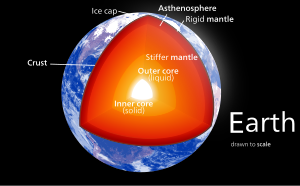Our website is made possible by displaying online advertisements to our visitors.
Please consider supporting us by disabling your ad blocker.
Crust (geology)

In geology, the crust is the outermost solid shell of a planet, dwarf planet, or natural satellite. It is usually distinguished from the underlying mantle by its chemical makeup; however, in the case of icy satellites, it may be defined based on its phase (solid crust vs. liquid mantle).
The crusts of Earth, Mercury, Venus, Mars, Io, the Moon and other planetary bodies formed via igneous processes and were later modified by erosion, impact cratering, volcanism, and sedimentation.
Most terrestrial planets have fairly uniform crusts. Earth, however, has two distinct types: continental crust and oceanic crust. These two types have different chemical compositions and physical properties and were formed by different geological processes.
Previous Page Next Page


